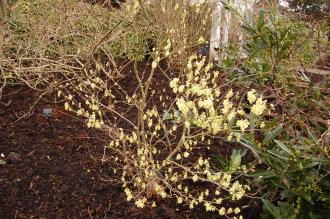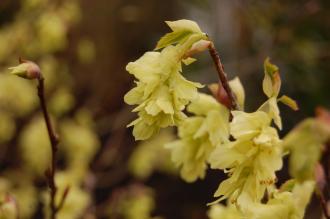
Corylopsis glabrescens (29/03/2015, Kew Gardens, London)
Position: Full sun to partial shade
Flowering period: Early spring
Soil: Moist, well drained, acid
Eventual Height: 5m
Eventual Spread: 5m
Hardiness: 5b, 6a, 6b, 7a, 7b, 8a, 8b, 9a
Family: Hamamelidaceae
Corylopsis glabrescens is a deciduous shrub with a spreading habit. Its dark green leaves are broadly ovate with serrate margins, greyish on their undersides, up to 10cm long and 7cm across. Its leaves may turn yellow in autumn before they fall. Its fragrant yellow flowers are cruciform in shape, borne in pendant racemes which are up to 4cm long and appear before its leaves. The fruit is a small, dry, 2 valved capsule.
Corylopsis glabrescens, commonly known as Fragrant Winter Hazel, is native to Japan and Korea.
The etymological root of the binomial name Corylopsis is derived from the Greek korylos meaning Hazel and oyis meaning ‘appearance’, in reference to the leaves’ similarity to those of the Hazel. Glabrescens is derived from the Latin glabra meaning ‘hairless’ and the epithet -escens meaning ‘-ish’.

Corylopsis glabrescens Flower (29/03/2015, Kew Gardens, London)
The landscape architect may find Corylopsis glabrescens useful as an attractive early spring flowering shrub. It is suitable for an informal hedging plant. It prefers a sheltered location.
Ecologically, Corylopsis glabrescens flowers are attractive to pollinating insects.
Corylopsis glabrescens prefers moist, humus rich, well-drained soils. It prefers an acid pH of soil.
Corylopsis glabrescens requires little maintenance.

